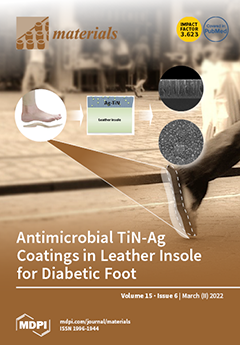Strong nonlinear absorption (NLA), reduced optical limiting (OL) thresholds, and high radiation shielding parameters are required for the effective use of glasses in the laser radiation and nuclear radiation protecting materials. In view of this, the efficacy of Sm
2O
3 on
[...] Read more.
Strong nonlinear absorption (NLA), reduced optical limiting (OL) thresholds, and high radiation shielding parameters are required for the effective use of glasses in the laser radiation and nuclear radiation protecting materials. In view of this, the efficacy of Sm
2O
3 on the nonlinear optical (NLO) and OL properties were ascertained (at 532 nm) along with radiation shielding characteristics. The open and closed aperture Z-scan profiles revealed the presence of positive NLA and nonlinear refraction (NLR) phenomena respectively. OL measurements showed the existence of limiting behavior in the studied glasses. The NLA and NLR coefficients were improved while the OL thresholds were decreased as the doping of Sm
2O
3 elevated to a higher doping level. These improvements in NLA, NLR coefficients and OL efficiencies were attributed to the non-bridging oxygens and high polarizable Sm
3+ ions. The NLA and OL results clearly suggest the high (5 mol %) Sm
2O
3 doped glass (Sm5CNLB) glass is beneficial to protect the delicate devices and human eye by suppressing the high energy laser light. The theoretical linear attenuation coefficients (LAC) values of the presented Sm
xCNLB glasses were obtained with the help of Phy-X software between 0.284 and 1.333 MeV. At 0.284 MeV, the maximum values occur and take values between 0.302 (for Sm0CNLB) and 0.409 cm
−1 (for Sm5CNLB). We found that the LAC for the presented Sm
xCNLB glasses is a function of Sm
2O
3 content, where the LAC tends to increase, corresponding to the high probabilities of interaction, as the content of Sm
2O
3 changes from 0 to 5 mol %. The effective atomic number (Z
eff) for the presented Sm
xCNLB glasses was examined between 0.284 and 1.333 MeV. As the amount of Sm
2O
3 is added, the Z
eff increases, and this was observed at any energy.
Full article






